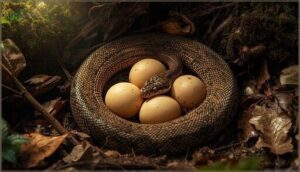This site is supported by our readers. We may earn a commission, at no cost to you, if you purchase through links.

Female snakes release these scent molecules through their skin, and males detect them using their forked tongues and a special organ called the Jacobson’s organ.
You’ll find male snakes following these invisible trails like bloodhounds, sometimes traveling considerable distances to locate receptive females.
The process becomes even more fascinating when multiple males discover the same female – they’ll engage in wrestling matches or form "mating balls" where dozens of males compete for one female’s attention.
Some species also use vibrations and visual displays during courtship, creating an intricate dance of attraction that’s both primitive and remarkably sophisticated.
Table Of Contents
- Key Takeaways
- How Do Snakes Find a Mate?
- How Do Male Snakes Find Females?
- Courtship and Mating Rituals
- Competition for Mates
- Unique Reproductive Anatomy
- Female Reproductive Strategies
- Mating Habits and Duration
- Birthing Period and Frequency
- Egg-laying Snakes
- Snake Parental Care and Offspring
- Frequently Asked Questions (FAQs)
- How do male snakes find females?
- Do snakes have one mate for life?
- How do snakes get other snakes pregnant?
- What does a female snake do after mating?
- How do snakes know where to find a mate?
- Do snakes flirt?
- How do male snakes compete for a female?
- Whats the deal with snake anatomy?
- Do female snakes have any say in the matter?
- Do snakes have specific breeding territories?
- Conclusion
Key Takeaways
- You’ll watch male snakes use their forked tongues like chemical GPS systems – they flick their tongues to detect pheromones that females release, then follow these invisible scent trails across considerable distances to locate potential mates.
- You’ll witness intense male competition through wrestling matches and mating balls – when multiple males find the same female, they’ll pin each other’s heads to the ground or form massive clusters where dozens of males compete for one female’s attention.
- You’ll discover that female snakes control the reproductive process – they can store viable sperm for up to five years, choose which male’s genetics fertilize their eggs, and even reproduce without males through parthenogenesis in some species.
- You’ll find that male snakes have unique dual reproductive organs called hemipenes – they use only one at a time during mating and can create sperm plugs to prevent other males from mating with the same female afterward.
How Do Snakes Find a Mate?
Snakes use scent tracking and sensory adaptations to find their perfect match.
You’ll discover that male snakes follow pheromone detection trails left by females, using their forked tongues to sample airborne chemicals.
This mate selection process relies heavily on courtship signals through chemical communication rather than visual cues or vibrational signals.
Snake mating behavior centers on following these invisible highways of scent, ensuring reproductive success through sophisticated snake courtship rituals that have evolved over millions of years.
How Do Male Snakes Find Females?
When you’re watching nature’s dating game unfold, male snakes rely on sophisticated scent trail tracking to find their perfect match.
Their tongue-flicking behavior works like a built-in GPS system, detecting snake chemical signals and pheromone detection markers left by receptive females.
Here’s how males master this ancient art of romance:
- Snake pheromone detection through specialized tongue sensors
- Following scent trail tracking across their mate location range
- Compensating for pheromone degradation in challenging environments
- Using snake visual cues alongside chemical detection
- Breeding ground return patterns for seasonal encounters
This snake mating behavior involves males like garter snakes and racers actively pursuing mature females, creating nature’s most determined love story through snake courtship strategies.
Courtship and Mating Rituals
Once you’ve found a potential mate through pheromone detection, snakes don’t just jump straight into mating—they have their own courtship playbook.
These rituals include chin-rubbing along the female’s body, tail quivering to show interest, and even coital neck biting during the actual mating process.
Pheromone Trails and Detection
Male snakes follow pheromone trails like bloodhounds tracking scent.
Their snake pheromone detection system uses tongue-flicking mechanics to sample chemical signals from air and ground.
The vomeronasal organ processes these snake chemical signals, identifying female reproductive status and location through pheromone specificity.
Snakes also use their tongues to enhance chemical trail detection for locating mates.
| Detection Method | Function |
|---|---|
| Tongue Sampling | Collects airborne chemicals |
| Ground Contact | Detects surface pheromones |
| Air Analysis | Processes chemical concentration |
| Trail Following | Maintains directional tracking |
| Signal Processing | Interprets reproductive readiness |
Aquatic pheromone challenges complicate underwater detection, while scent trail composition varies by species and environmental conditions.
Chin-rubbing, Tail Quivering, Coital Neck Biting
After detecting each other through pheromone trails, you’ll witness fascinating snake courtship behaviors that seem almost like a choreographed dance.
These snake communication methods involve specific snake body language patterns that serve essential biological functions in snake mating behavior.
Here’s what these ritualistic behaviors accomplish:
- Chin-rubbing purpose – Males stroke females’ bodies to stimulate receptiveness and assess reproductive readiness through direct contact
- Tail-quivering signals – Rapid tail movements communicate male interest while triggering female hormonal responses for mating
- Coital-bite function – Neck biting during copulation helps males maintain position and may induce a trance-like state in females
- Sensory involvement – These ritualistic aggression patterns allow snakes to exchange chemical information through snake pheromones
Competition for Mates
When you find a snake seeking a mate, you’re witnessing some of nature’s most intense competitions.
Male snakes don’t just politely wait their turn—they engage in wrestling matches and form massive "mating balls" where dozens of males compete for a single female’s attention, creating a spectacle of intense competitions.
Male-male Rivalry and Combat
When competition heats up, you’ll witness intense snake wrestling matches where males pin rivals’ heads to the ground.
Combat tactics include striking with closed mouths and body coiling.
Dominance displays determine access to females through sheer size advantage and rivalry intensity.
| Combat Behavior | Description |
|---|---|
| Wrestling | Males intertwine and attempt to pin opponents |
| Head Pinning | Dominant snake forces rival’s head to ground |
| Mock Striking | Closed-mouth strikes to intimidate competitors |
| Size Assessment | Larger males typically gain winners advantage |
Hemipenis injuries can occur during fierce male competition, making snake mating competition a high-stakes battle for reproductive success.
Males often fight for access to the female’s cloaca, and pheromones attract mates, further intensifying competition.
Formation of Mating Balls
In nature’s wildest competition, you’ll witness garter snake balls where dozens of males swarm around one female.
These writhing clusters demonstrate raw evolutionary strategy as males battle for mating success through sheer persistence and positioning.
Key Ball Dynamics:
- Competition intensity peaks with up to 100 males competing for a single female
- Pheromones guide males to form these temporary mating assemblies during spring emergence
- Evolutionary purpose guarantees only the most determined males achieve reproductive success
These gatherings are examples of snake mating balls.
Unique Reproductive Anatomy
When you look at snake reproduction, you’ll discover that male snakes have some truly unique equipment that sets them apart from other animals.
Unlike most creatures, male snakes possess two reproductive organs called hemipenes, which they use alternately to maximize their mating success and guarantee genetic diversity.
Male Snakes’ Hemipenes and Their Function
Unlike most mammals, you’ll find that snakes possess fascinating dual reproductive organs called hemipenes.
Their hemipenis morphology represents a remarkable evolutionary advantage in snake reproductive anatomy.
Here’s how these snake sex organs work:
- Erection Mechanism: Hemipenes stay inverted inside the cloaca until blood flow creates an erection mechanism that everts them during snake mating.
- Sperm Delivery: Only one hemipenis functions per mating session, featuring grooves that channel sperm delivery directly into the female’s reproductive tract.
- Mating Plug: Many species have spiny or hooked surfaces that create a temporary mating plug, ensuring successful fertilization while preventing rivals from interrupting.
This dual-penis system lets males mate consecutively without recovery time, maximizing their reproductive success during breeding season.
Male Red-sided Garter Snakes’ Sperm Plug
While male hemipenes enable successful snake mating, red-sided garter snake males take reproduction one step further with their mating plug strategy.
After copulation, you’ll find these males deposit a thick, gelatinous secretion into the female’s cloaca. This plug composition creates a physical barrier that blocks other males from mating with the same female.
The mating benefits are clear – by preventing rival sperm from entering, the original male’s genetic material gets priority access. However, female receptivity isn’t completely eliminated since females can remove these plugs if they contain insufficient sperm.
Plug removal typically occurs when females actively seek additional mates, though the process requires significant energy investment. The process of pheromone mimicry can also influence mating opportunities.
This evolutionary significance reflects intense male competition during spring emergence when operational sex ratios heavily favor males. The sperm storage system in females, combined with plugs that dissolve over time, creates a complex reproductive battleground where timing and plug effectiveness determine success.
Female Reproductive Strategies
You’ll discover that female snakes have remarkable control over their reproductive destiny through sophisticated biological mechanisms.
Unlike many animals, female snakes can store sperm for up to five years and even reproduce without males through a process called parthenogenesis.
Sperm Storage and Fertilization Control
While male snakes have evolved impressive reproductive equipment, you’ll find that female snakes hold the real power in reproduction through their extraordinary sperm storage abilities.
Female snakes can store viable sperm for up to five years, giving them complete control over when fertilization occurs and which male’s genetics contribute to their offspring.
This snake reproductive strategy allows females to time reproduction perfectly with environmental conditions, ensuring their young have the best survival chances.
When multiple males compete for mating rights, females benefit from sperm competition occurring inside their bodies, potentially improving offspring quality through Multiple Paternity.
Here’s how female snakes maximize their reproductive success:
- Delayed Fertilization – Store sperm until favorable breeding conditions arise
- Mate Selection – Choose which stored sperm fertilizes eggs
- Sperm Viability – Maintain fertile sperm for years without degradation
- Fertilization Timing – Control when eggs develop based on environmental factors
- Asexual Reproduction – Some species can reproduce without males entirely
This remarkable control over reproduction gives female snakes significant advantages in survival and species continuation.
Parthenogenesis in Certain Snake Species
Some female snakes pull off an incredible trick called parthenogenesis – they create babies without any male involvement whatsoever.
This asexual reproduction process, also known as virgin birth, lets species like ball pythons and boa constrictors reproduce when males aren’t around.
Parthenogenesis triggers kick in during isolation or stress, giving these snake species a serious evolutionary advantage.
While it reduces genetic diversity, this backup snake reproductive strategy guarantees survival when traditional mating isn’t possible.
Some species also engage in promiscuous mating rituals to increase genetic diversity.
Mating Habits and Duration
Once you understand the basics of snake attraction, you’ll find that mating habits vary dramatically based on environmental factors.
Climate conditions and food availability directly influence how often snakes breed, while males engage in wrestling matches to win mating rights with females.
Influence of Climate, Food Availability
You’ll find that climate breeding cycles and food-driven reproduction dramatically shape when snakes mate.
In tropical regions, snakes can breed year-round thanks to stable temperatures, while colder climates restrict mating to post-hibernation periods.
Rainfall mating cues and abundant prey trigger heightened reproductive activity.
Temperature sperm viability directly affects breeding success, and habitat mate density influences competition levels during peak seasons.
Male Competition Through Play Fights
When you witness snake mating behavior, you’ll notice intense agonistic behavior as males engage in ritualized combat.
These dominance displays involve wrestling matches where competitors pin each other’s heads, demonstrating remarkable energy expenditure.
This male snake competition represents essential evolutionary significance in animal mating behavior, ensuring only the strongest reproduce through these strategic snake mating strategies.
The process of snake mating also involves complex snake mating rituals that play a pivotal role in the reproduction of snakes.
Birthing Period and Frequency
Once you understand how snakes find their mates, you’ll want to know what happens next in their reproductive cycle.
Snake birthing patterns vary dramatically between species, with some laying eggs annually while others give birth to live young every two to three years depending on climate and food availability.
Nest Abandonment and Brooding
Throughout nature’s vast tapestry, snake parental care varies dramatically after egg incubation begins.
You’ll discover fascinating differences in brooding habits across species:
- Protective pythons coil around eggs, regulating temperature and humidity for ideal hatchling survival
- Attentive pit vipers guard newborns for several days after birth
- Abandoning species leave eggs immediately, forcing instant independence
- Environmental factors like storms trigger nesting behavior changes in many populations
This spectrum of snake parental care reflects diverse evolutionary strategies, with some mothers investing heavily in offspring while others rely on quantity over quality for reproductive success.
Snake Species Variations in Birth Frequency
While most snakes abandon their eggs after laying, the story doesn’t end there.
Snake species identification reveals fascinating reproductive patterns across different lineages.
You’ll find that birth cycles vary dramatically between species, creating a complex web of mating seasons and reproductive strategies.
Frequency and Seasonality: Some snakes give birth once or twice yearly, while others reproduce every three years.
Black rat snakes demonstrate this species variance perfectly – they’ll mate annually in moderate climates but only every 2-3 years in colder regions where energy conservation becomes critical.
Climate-Driven Adaptations: Snake mating behavior adapts to environmental pressures.
Consider how:
- Garter snakes can produce 15-85 babies annually, maximizing reproductive output
- Timber rattlesnakes follow prolonged cycles, sometimes waiting years between breeding
- Brazilian rainbow boas time births with seasonal food availability peaks
Evolutionary Strategies: Snake birth frequency reflects survival tactics.
Viviparous species like rattlesnakes often reproduce less frequently but invest more energy per offspring.
This reproductive strategy helps baby snakes survive harsh conditions that would destroy eggs.
Snake mating habits showcase nature’s remarkable adaptability to environmental challenges.
Egg-laying Snakes
When you think about egg-laying snakes, you’re looking at about 70% of all snake species that develop their babies inside protective shells.
These mothers carefully choose hidden spots like rotting logs, sandy soil, or compost piles where their leathery eggs can stay warm and safe during the 6-12 week incubation period.
Development Inside The Mother
You’ll find that ovoviviparous species keep their developing eggs inside their bodies throughout the entire gestation period.
During embryo growth, maternal nutrition directly supports fetal development through the yolk sac. These viviparity mechanisms allow mothers to control temperature and protect their young from predators.
Live birth occurs when the embryos have completed their development, giving these snake reproductive strategies a significant advantage over traditional egg-laying methods for reproductive success.
Egg-laying Locations and Hatching Time
When you’re dealing with oviparous snake species, nest site selection becomes vital for reproductive success.
Female snakes carefully choose protected, damp locations like rotting logs, underground burrows, or rock crevices where their leathery snake eggs can develop safely.
The incubation period length typically spans 45-70 days, depending on environmental conditions and species requirements.
Here are key factors affecting snake egg incubation:
- Clutch size variation: Most species lay 10-15 eggs, though this ranges from 4-80 depending on the female’s size and species
- Eggshell characteristics: Snake eggs feature leathery shells that allow gas exchange while maintaining moisture during development
- Hatchling emergence success: Baby snakes use their specialized egg tooth to break free, with most clutches hatching synchronously within hours
Temperature and humidity levels must remain consistent throughout snake egg incubation for ideal hatchling emergence success.
For consistent results, some breeders opt for a reptile egg incubator.
Snake Parental Care and Offspring
Once you’ve watched eggs develop or witnessed live births, you’ll discover that snake parental care breaks all the rules you’d expect. Most snake species practice the "drop and dash" approach to parenting, but some remarkable exceptions exist that’ll surprise you.
Python Coiling represents nature’s most dedicated snake mothering. Female pythons wrap around their eggs like living blankets, regulating temperature and humidity while defending against predators. This Maternal Investment can last weeks until hatching occurs.
Pit Viper Guarding offers another fascinating example. These venomous mothers stay with newborns for several days, providing protection during their most vulnerable period. It’s snake reproduction at its most caring.
Here’s what you need to know about snake offspring:
- Hatchling Self-Sufficiency means babies emerge ready to hunt immediately
- Each hatchling uses its Egg Tooth to break free from leathery shells
- Most species abandon nests completely after laying
- Snake mating behavior influences whether mothers invest in parental care.
Snake mate selection and snake reproductive behavior determine these caring patterns, making parental investment rare but remarkable when it occurs. Some enthusiasts even study python egg incubation in detail.
Frequently Asked Questions (FAQs)
How do male snakes find females?
Like bloodhounds following a scent trail, you’ll watch male snakes flick their tongues to detect pheromones. They follow these chemical breadcrumbs that females leave behind when they’re ready to breed.
Do snakes have one mate for life?
No, snakes don’t mate for life.
They’re complete commitment-phobes who abandon their partners right after mating.
Most species have zero interest in forming lasting bonds, instead focusing on finding multiple mates during breeding season for maximum reproductive success.
How do snakes get other snakes pregnant?
Male snakes use their hemipenes (dual reproductive organs) to fertilize females after detecting pheromone trails and engaging in courtship behaviors like chin-rubbing and tail-wrapping during mating season.
What does a female snake do after mating?
After mating, you’ll find female snakes storing sperm for up to five years, controlling when fertilization occurs.
Their pheromones diminish, reducing male interest, and they’ll eventually lay eggs or give live birth depending on species.
How do snakes know where to find a mate?
Imagine nature’s GPS system at work – you’ll find snakes using their forked tongues like chemical detectors, flicking them to pick up pheromone trails that females leave when they’re ready to breed.
Following these scent highways straight to potential mates is a remarkable process.
It involves snakes using their forked tongues to follow the pheromone trails that females leave behind.
Do snakes flirt?
Snakes don’t flirt like humans, but they’ve got their own romantic moves. Males perform courtship rituals including chin-rubbing, tail-quivering, and gentle caresses to convince females they’re worthy mates.
How do male snakes compete for a female?
Winner takes all, they say. You’ll witness intense battles as male snakes wrestle competitors, pinning heads to the ground and forming mating balls around desirable females, fighting for exclusive access.
Whats the deal with snake anatomy?
Male snakes possess two reproductive organs called hemipenes, but they’ll only use one at a time during mating.
These organs are stored inverted inside their bodies and feature spines for secure attachment.
Do female snakes have any say in the matter?
Like a chess player weighing her options, you’ll find female snakes aren’t passive participants.
They can reject males, choose which sperm fertilizes their eggs, and even store sperm for years before deciding when to reproduce.
Do snakes have specific breeding territories?
Most snakes don’t establish specific breeding territories.
Instead, you’ll find males actively searching across their habitat range to locate females.
Some species return to traditional breeding grounds seasonally, while females often remain stationary.
Conclusion
Remarkably, understanding how snakes find a mate reveals nature’s intricate chemical communication system at work.
You’ve discovered that these reptiles rely primarily on pheromones, specialized organs, and complex behaviors to locate breeding partners.
From following scent trails to engaging in wrestling matches, snakes demonstrate surprisingly sophisticated reproductive strategies.
Their unique anatomy, including hemipenes and sperm storage capabilities, enables successful reproduction despite their solitary nature.
Next time you encounter a snake, you’ll appreciate the remarkable biological processes that guarantee their species’ survival, and understand how these processes contribute to the species’ survival.
- https://scalecompanions.com/do-snakes-have-sex/
- https://www.reptileknowledge.com/reptile-pedia/how-do-snakes-pick-their-mates
- https://wildhabitants.com/how-do-snakes-mate/
- https://talis-us.com/blogs/news/do-snakes-go-into-heat-exploring-snake-reproduction?srsltid=AfmBOoqob9yNMTUS6yoteKTv6aUnJjJDwdLi7v0yO_iPnj6WxSz5uFKR
- https://reptilestartup.com/discover-how-snakes-reproduce-do-snakes-mate/


















